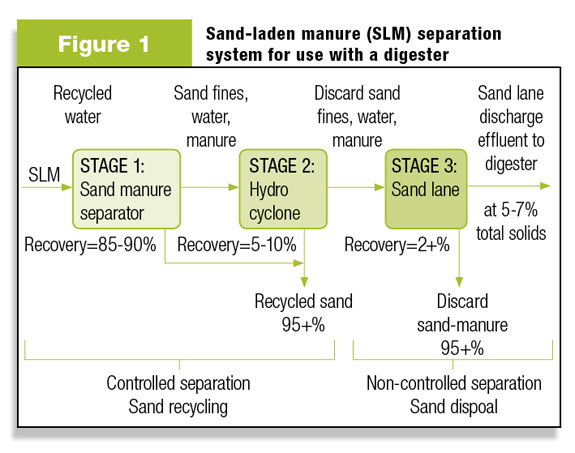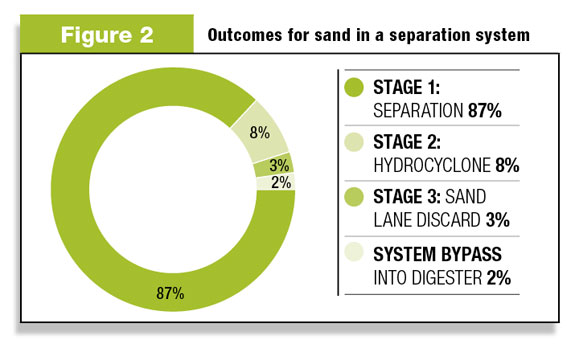Implementation of anaerobic digestion technology on U.S. dairies continues to stumble along. There are several reasons, with the most prevalent being economics, including: high capital costs, high or unknown operation and maintenance costs, reliability concerns and low revenues. Anaerobic digestion technology is proven to work, but the dollars and cents situation is simple reality and largely out of the control of producers. Despite the environmental benefits, a segment of producers also steer away from anaerobic digestion systems due to the perceived notion manure is the only bedding option. Here’s how sand bedding users are implementing sand-manure separation as part of digestion pretreatment.
Cow comfort: A component in an anaerobic digestion system
Cow comfort and the freestall environment are part of a complete anaerobic digestion system since the dairy’s choice of bedding must often pass through system or be separated out prior to it. Digester designers traditionally stipulate the use of manure solids for bedding.
However, manure bedding can experience increased bacteria counts. Sand for bedding should not be automatically ruled out if a dairy is considering a digester.
Implementation of mining equipment and associated system design methodologies to separate sand from manure prior to digestion has proven successful over the long term on dairies.
Conventional manure-handling equipment relies on materials of construction, component selection and speeds that are not conducive to long service life in the presence of sand. Mining duty equipment and systems are used to process sand gravel and crushed stone for construction purposes.
Sand and gravel plant operators require high recovery of fines so as not to fill ponds and to produce a maximum amount of usable sand product. These goals are in complete alignment with those of a dairy operation.
From challenges some opportunities
Sand bedding has a history of causing manure-handling challenges even with relatively straightforward systems such as daily haul and short-term or long-term storage. Anaerobic digestion systems are particularly susceptible to sand settling and equipment wear.
Digesters are complex networks of influent piping and sealed tanks lacking loader access. Even small amounts of bypass sand, over time, can be exceptionally problematic.
Consider a 1,000-cow dairy using sand at a rate of 50 pounds per cow per day. Assuming 5 percent bypass, 2,500 pounds of sand per day – almost one cubic yard or 200 gallons per day – would be introduced to the digester daily.
In addition to bedding sand, manure contains grit from other sources like blow sand, degrading concrete, soil from harvesting, etc. Grit from these sources, often overlooked by designers, alone causes anaerobic digester failures even on dairies not bedding with sand.
Some bypass sand, by virtue of the viscous nature of the digester tank contents, stays in suspension and discharges from digester tanks. Nevertheless, the goal should be complete sand removal to relieve all doubt as to the fate of bypass sand.
Although 100 percent sand recovery pre-digestion is not practically achievable without also removing a substantial portion of organic solids where settling processes are concerned, digesters are operating successfully over the long term where concrete sand is used as bedding and 95 percent sand recovery or greater is achieved.

Three stages of sand-manure separation are necessary to achieve maximum sand recovery. ( Figure 1 ) Each stage is designated as either controlled (sand recycle) or non-controlled (sand disposal) separation.
Overall system performance
Sand reclaimed from a sand-manure separation system contains less than 2 percent organic matter and may be recycled back to milk cows within one month.
Overall recovery of usable sand (stages 1 and 2) is approximately 95 percent when washed concrete sand is used originally.
Concrete sand is best for separation since a majority of sand fines are washed out during the manufacturing process.
In addition to the recycled sand, an additional 3 percent of sand is captured on the sand lane (stage 3) and land applied. Recovered sand-lane sand has an organic matter content of 5 percent and is judged too dirty for reuse.
Overall sand recovery for the three stages of separation is approximately 98 percent. The remainder of the sand (1.7 percent) bypasses the separation process and is discharged to the digester. For 3,500 cows, 1.7 percent bypass represents approximately 3,027 pounds of sand per day or one cubic yard.
Although some of this sand could eventually settle in an anaerobic digester vessel, the majority of it is extremely fine (less than 100 mesh) and will remain in suspension due to the viscosity of the manure. Digester designers should have a contingency plan in place to address potential sand accumulation in tanks.

As previously described, due to the dilution necessary to facilitate sand settling, sand-laden manure is typically introduced to a sand-manure separation system at approximately 30 percent of total solids.
Sand lane (stage 3) liquid discharge, which is a digester influent, ranges between 5 and 7 percent of total solids.
Due to the dilute nature of the separation system discharge, any anaerobic digester receiving this influent will include some kind of mixing. Low total solids concentrations are best suited for mixed plug flow or complete mix systems.
Digester designers should be aware of the composition of effluent post separation, particularly total solid and organic solids. Lower total solids creates a higher parasitic heat load and potentially a system with lower energy output when compared to undiluted anaerobic digester influents.
Generally speaking, biogas production is decreased since organic solids are captured in sand throughout the separation settling processes. The organic solids are otherwise fuel for digestion. Approximately 4 percent of the organic matter introduced to a separation system is lost to the separated sand.
Putting the pieces together
Anaerobic digestion technology is tried and true. Failures are most often mismanagement and/or the loss of “inspiration” to operate systems in light of poor economics.
Cow comfort is indeed a critical component of a dairy digester system. There is little doubt sand bedding can be problematic in the network of pipes and gas-tight vessels that are anaerobic digesters.
In fact, decades of experience with anaerobic digestion has shown sand and other settleable materials potentially cause problems even where sand isn’t used for bedding.
However, the mining industry has sand processing goals similar to those of a dairy farm. These mining duty systems are proven on large dairies over the long term.
Use of mining duty technologies as part of anaerobic digestion systems has the potential to increase anaerobic adoption. No longer is it necessary to choose between cow comfort (sand bedding) and manure handling (anaerobic digestion). PD
Wedel is an agricultural engineer with McLanahan Corporation . Click here to reach him.





